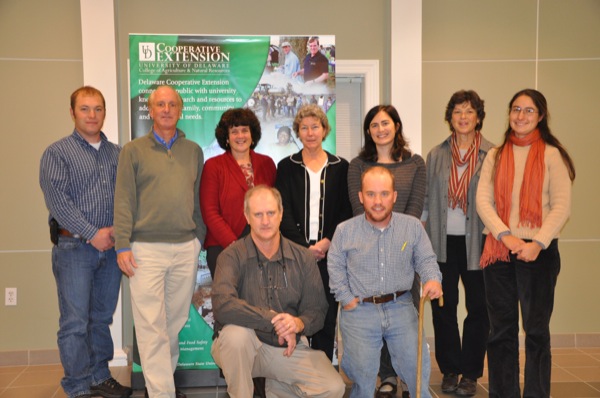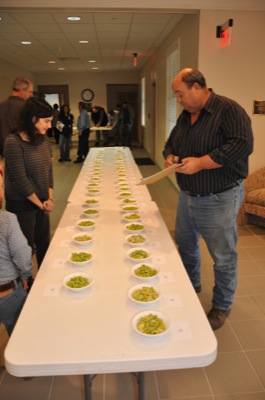


Lima bean grant
UD awarded $1.5 million USDA grant to study lima beans
8:55 a.m., Jan. 11, 2013--Delaware is currently the number two producer of lima beans in the United States, second only to California and with the possibility of becoming number one in the future.
Because of this, it is imperative to study the many aspects of various diseases affecting the crop in Delaware and throughout the mid-Atlantic region.
Research Stories
Chronic wounds
Prof. Heck's legacy
Such work requires a collaborative effort and a team has been assembled thanks to a five-year, $1.5 million U.S. Department of Agriculture (USDA) Specialty Crop Research Initiative grant.
The grant awarded to the University of Delaware includes researchers from UD, Delaware State University, the University of Maryland, Ohio State University, Cornell University and the University of California Davis (UC Davis) who will begin studying the various effects of plant disease on lima beans in the First State.
The many aspects of this grant will include studies that are being conducted for the first time in history.
There are six components to the grant, each with various researchers studying different parts of the problem. They are conducting research on downy mildew, pod blight, white mold, root knot nematodes and germplasm resources and developing an economic analysis.
Downy mildew
Downy mildew is a fungal-like disease of the lima bean caused by Phytophthora phaseoli and the goal of the research team is to improve disease forecasting and look at genetic diversity of the population of the pathogen. In this way, researchers will be able to inform farmers of their risk of occurrence of the disease and have a better understanding of the genetics of the pathogen.
Tom Evans and Nicole Donofrio, professors of plant pathology in the Department of Plant and Soil Sciences in UD’s College of Agriculture and Natural Resources, and Nancy Gregory, plant diagnostician for UD, will work together on this part of the project.
Pod blight
Pod blight is caused by the pathogen known as P. capsici and Gordon Johnson, assistant professor of plant and soil sciences at UD, will work on this part of the study with Evans and Gregory.
Unlike downy mildew, which is a disease that generally affects only lima beans, P. capsici has a very wide host range. Once it strikes a particular crop, it is very difficult to get rid of, with pathogen’s spores lasting up to 10 years in the soil. Because of this, pod blight is an increasing problem for growers. The disease occurs in low-lying areas of fields and is more frequent in wet years. Therefore, this part of the project has three goals: to look for a fungicide to deal with the disease, to monitor the disease, and to look for alternative or organic non-pesticide driven strategies for control.
The study is also looking at risk management strategies, including information for growers in the state about the best time to spray for disease control and consideration of alternate control strategies.
Gregory, who diagnoses field samples collected by the research team and growers, maintains cultures of the pathogens and produces the inoculum for the studies, said that the researchers are eager to “learn more about the epidemiology and the spread of pod blight and downy mildew, that will enable us to do a little bit better job on forecasting.”
She also noted how great is to have so many expert researchers involved, noting that she is looking forward to making significant progress on problems that have plagued the region for years. “To pull together a strong team of researchers like this and many new graduate students is really going to pull a lot of this research together and we’ll really come up with some great results.”
White mold
Kate Everts, an adjunct associate professor of plant and soil sciences at UD and a Cooperative Extension specialist with both UD and the University of Maryland, is leading research on alternative ways to control white mold, another disease that is very difficult to eliminate.
With an even broader host range than P. capsici, and an even longer life — persisting in soils for 20-30 years — finding out as much about the disease as possible, as well as possible ways to control it, is imperative.
Everts will look not just at lima beans but other crops, as well, as she tests biological control strategies and alternative control strategies for dealing with the white mold.
Root knot nematodes
Johnson and Emmalea Ernest, a Cooperative Extension associate in plant and soil sciences and plant breeder, will lead research on root knot nematodes, another insidious pest that impacts crops. Researchers will screen new germplasm for resistance and look at how it impacts root knot in Delaware.
Paul Gepts, a research collaborator on the grant from the UC Davis, has cultivars that are resistant to root knot nematodes in California, so the researchers are going to evaluate those cultivars in Delaware . If the California cultivars are resistant in Delaware, they can be used to breed nematode resistant lima bean varieties for this state.
The second part of this research is to use local weather and soil condition data -- such as depth and length of freeze, soil temperature ranges and soil moisture -- to help determine what types of conditions root knot nematodes thrive in. They will also be evaluating different assay methods to improve detection of root knot nematodes.
The researchers will use this environmental data and soil type to predict when and where the nematodes are likely to be a problem and develop root knot risk field assessment guides for growers.
Lastly, they also will evaluate alternative control measures for root knot nematodes. As Donofrio points out, “Each objective in this part of the project is designed to take an integrated approach, so each has a goal of providing the growers something to do other than spray fungicides all the time in a heavy disease situation.”
Germplasm resources
Researchers in this portion of the project will characterize the available germplasm resources to assist in the breeding of new varieties of the lima bean, going beyond disease resistant and looking to create new resources for the future.
Ernest has access to a wide diversity of lima bean germplasm from around the world but utilizing this material in breeding is difficult, partly because it has not been genetically characterized.
Randy Wisser, UD assistant professor of plant and soil sciences, and Blake Meyers, chair of the Department of Plant and Soil Sciences and the Edward F. and Elizabeth Goodman Rosenberg Professor of Plant and Soil Sciences, will determine how lima differs genetically using a technique that Wisser pioneered for lima beans.
The technique is called Reduced Representation Sequencing and it uses next generation sequencing to look at a subset of an organism’s genome to determine how genetically different one organism is from another.
The hope is to understand the genetic diversity of the lima bean and cross genetically diverse lines with desirable traits to develop populations that can be used for genetic studies. The eventual goal is to better understand the genetics of underlying traits of interest and develop molecular markers that can be used to accelerate development of improved varieties.
These genetically diverse lines could be used to study many traits of interest beyond disease resistance, such as heat and drought tolerance, which are also critical to growers.
Economic analysis
Titus Awokuse, professor and chair of UD’s Department of Applied Economics and Statistics, will lead an analysis aimed at determining the economic benefits of using the alternate methods of pest control developed through the study.
Results of the economic analysis will provide accurate information on current losses and costs, helping inform farmers of the potential of profitability from using the new approaches that will be developed by the study. Showing the state’s growers that these new approaches are environmentally friendly and also more cost effective is another crucial part of the research.
“For producers, the bottom line is that of profit, revenue and losses,” said Awokuse. “By being able to provide data to producers to let them know how profitable will it be for them if they use this new approach, we can then look at the economic impact of using one versus the other.”
Awokuse said that the group is “hoping that if the producers see that there is significant economic benefit to them for using the new approach that they will adopt it.”
The researchers believe this will be the first time an economic analysis of the lima bean will have been undertaken in the state.
The researchers will provide surveys to get feedback from field personnel, consultants, growers and processors, and will have meetings specific to this grant with everybody involved.
There is also an advisory board for the project that includes Delaware Secretary of Agriculture Ed Kee, who the researchers said has been extremely supportive of the project.
‘Research is very important’
William Donald Clifton II, a Milford area grower who plants about 800 acres of lima beans, said he was pleased that researchers at UD obtained the grant. Ernest used six acres of Clifton’s farm this summer for field trials on eight baby lima varieties.
Clifton said he is glad that UD is aggressive in seeking such grants, saying, “Other extension services go after the grants on the big crops, like corn and soybeans, but limas are a small crop and very important to us locally. Yields need to go to another plateau. The variety trials are important for that. This research is very important.”
Collaborators on the grant include Bob Mulrooney in plant and soil sciences and Joanne Whalen, extension specialist in entomology and wildlife ecology.
Collaborators from other universities include Venu Kalavacharla, associate professor in the department of agriculture and natural resources at Delaware State University; Bill Fry, professor in the Department of Plant Pathology and Microbe-Biology at Cornell University; and Larry Madden, Distinguished Professor in Plant Protection at Ohio State University.
In addition to these researchers, eight graduate students will be hired to work on various aspects of the project and a postdoctoral student will be added, along with an extension agent. In addition, field personnel and undergraduate students will assist with the research.
Article by Adam Thomas
Photos by Michele Walfred









